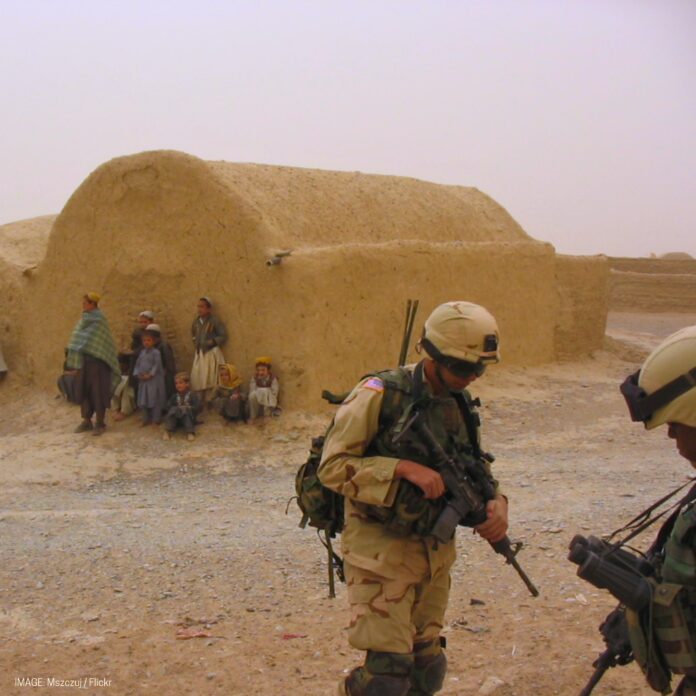Decades of the U.S. war, coupled with its climate vulnerability, puts Afghanistan at a high risk of experiencing disproportionate impacts of climate change. Afghanistan relies heavily on agricultural livelihoods, which are threatened by extreme weather events attributed to human-caused climate change and war.
Climate impacts across Afghanistan include frequent floods, glacial melt, prolonged periods of drought and landslides leading to food, water and shelter insecurity. In recent years, the country experienced a number of extreme climate effects, including a severe drought in 2018 that impacted more than 1 million people, and devastating floods in 2019 affecting more than 130,000 people.
Despite producing less than 0.01% of historical global carbon emissions that have caused global warming, Afghanistan is paying a heavy price for it.
Lasting Impacts of Environmental Damage
The relentless U.S. bombing of Afghanistan has left behind a trail of severe environmental devastation. The country’s soil lays barren with hidden unexploded bombs, depleted uranium, and other hazardous waste from daily operations at hundreds of U.S. military bases across Afghanistan. These environmental scars will haunt the nation for generations to come, entailing:
- Degraded grasslands from the damage to the soil
- Extinction of several animal species, including leopards
- Diminished pistachio cultivation and exports
- Severely impaired irrigation systems
- Contaminated water sources tainted with toxic chemicals
Who Pays for Environmental Clean-Up?
After almost 20 years of war, the U.S. has left behind hazardous and toxic waste at its military bases across Afghanistan upon exiting. Without conducting environmental remediation processes at its military bases, a procedure is necessary to ensure the sites are safe for future civilian use, the hazardous and toxic waste at these military bases can cause life-threatening impacts if left untreated, including cancer, for those in the vicinity.
Read More: Climate Oppression, Eco-Apartheid & Palestinian Occupation
There is currently a legal prohibition that stops the U.S. from spending on environmental remediation overseas. The clean-up costs of the environmental damage in Afghanistan can be up to $15 Million USD. The number of U.S. bases across Afghanistan has varied over the years, with estimates of 700 to 800 bases at the height of the US-led war in the country.
The Secret Carbon Bootprint of War
Did you know that militaries are not required to report their GHG emissions? Under the 1997 Kyoto Climate Accord, the U.S. negotiated a blanket military exemption to avoid reporting its military GHG emissions to the UNFCC. The 2015 Paris Climate Agreement removed this military exemption, however, it still only made military emissions reporting voluntary.
One estimate shows that the U.S. military is the single largest institutional source of greenhouse gas emissions in the world. The GHG emissions of the U.S. military from the war in Afghanistan, Pakistan, Iraq and Syria were more than 440 million tons of GHGs. In contrast, the GHG emissions of the entire country of Afghanistan during the period of 2001 – 2008 were only about 13 million tons.
How Can We Move Forward?
In a confluence of war and ecological vulnerability, Afghanistan stands as a poignant example of the intersections between geopolitical conflicts and the climate crisis. The lack of a mechanism for enforcing environmental remediation overseas is a real challenge for holding the U.S. accountable for its environmental damage in Afghanistan. The country’s plight highlights the pressing need for transparency in reporting the carbon footprint of the U.S. military. Additionally, climate justice for Afghanistan must include calling for necessary policy changes and reparations to enforce clean-up of the environmental damage caused by the U.S. military.
The war industry feeds on violence, unrest and human catastrophe – it not only exacerbates the impacts of climate change but also adds to the problem with its huge carbon and ecological footprint. Ultimately, divesting away from the war industry is a necessary step to combatting climate change.
References
- German Watch (2021). Global Climate Risk Index 2021. Report.
- UN Sustainable Development Group (2022). Finding common ground in Afghanistan’s fight against the climate emergency. Article.
- World Bank Group (2021). Climate change knowledge portal. Website.
- Our World in Data (2019). Who has contributed most to global CO2 emissions? Website.
- Neuhauser, J. A. (2015). U.S. military responsibility for environmental cleanup in contingency environments. Environmental Law, 45(1), 129–179.
- Scientific American (2021). U.S. forces are leaving a toxic environmental legacy in Afghanistan. Article.
- CBS News (2010). The 700 military of Afghanistan. Article.
- Investigative Reporting Workshop (2021). U.S. leaves Afghanistan, but military presence remains. Article.
- Khan, M. (2022). The environmental impacts of war and conflict. K4D Helpdesk Report. Institute of Development Studies.
- Center for Public Integrity (2015). U.S. troops burned waste in hazardous open pits when safer incinerators sat idle. Article.
- The New Republic (2016). The things they burned. Article.



